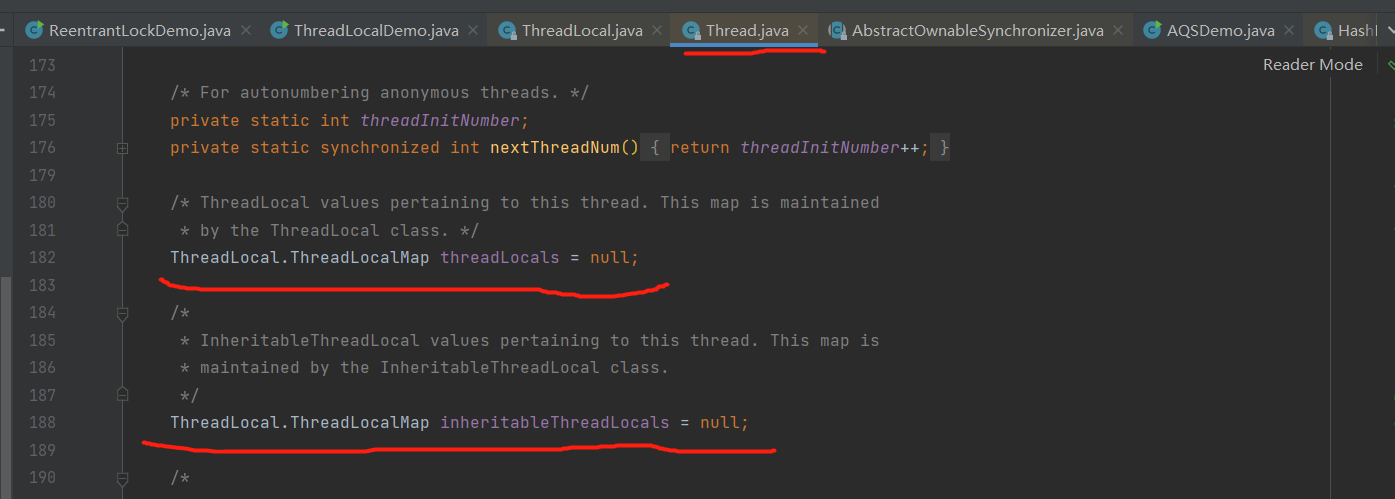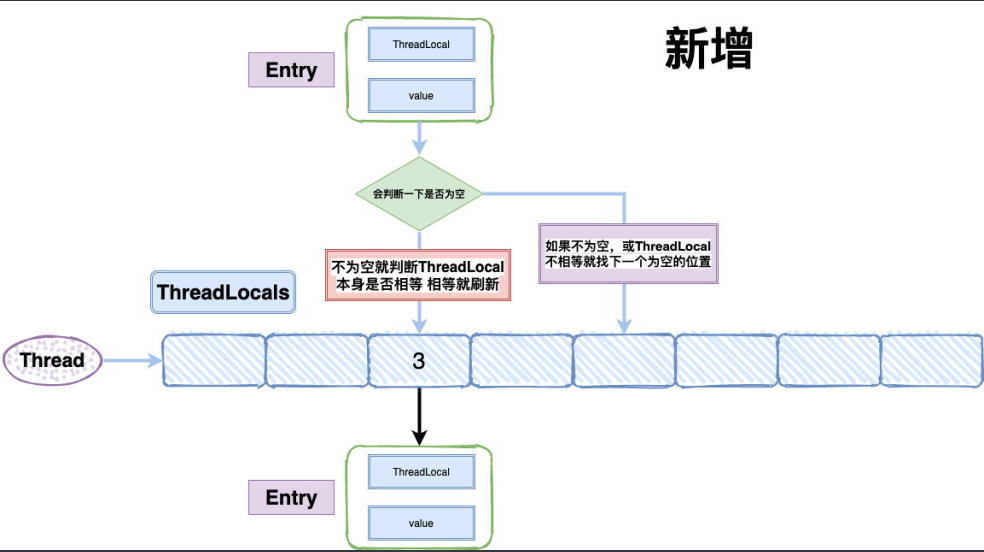定义
ThreadLocal的主要作用就是做数据隔离,填充的数据只属于当前线程,变量的数据对别的线程来说是相对隔离的,在多线程的情况下,防止自己的变量被其他线程篡改。
隔离有什么用,会用在什么场景?
Spring的事务隔离级别的实现
Spring采用ThreadLocal的方式,来保证单个线程中的数据库操作使用的是同一个数据库连接,同时,采用这种方式可以使业务层使用事务时不需要感知并管理Connection, 通过传播级别,巧妙的管理多个事务配置之间的切换、挂起和恢复。
Spring的事务主要就是通过ThreadLocal和AOP实现的,每个线程自己的链接都是通过ThreadLocal来保存的。
上下文中cookie、session等上下文用户信息
底层实现原理
使用
线程进来之后初始化一个可以泛型的ThreadLocal对象,之后这个线程只要在remove之前去get,都能拿到之前set的值,注意这里说是remove之前。
package com.interview.demo;/*** @Author leijs* @date 2022/4/2*/public class ThreadLocalDemo {public static void main(String[] args) {ThreadLocal<String> threadLocal = new ThreadLocal<>();threadLocal.set("123");System.out.println(threadLocal.get());}}
set 方法


主要关注下ThreadLocalMap.
这就是ThreadLocal数据隔离的真相,每个线程Thread都维护了自己的threadLocals变量,所以在每个线程创建ThreadLocal的时候,实际上数据是存在自己线程Thread的threadLocals变量里面,别人没法拿到。从而实现了隔离。
ThreadLocalMap底层结构是什么样子的?
static class ThreadLocalMap {/*** The entries in this hash map extend WeakReference, using* its main ref field as the key (which is always a* ThreadLocal object). Note that null keys (i.e. entry.get()* == null) mean that the key is no longer referenced, so the* entry can be expunged from table. Such entries are referred to* as "stale entries" in the code that follows.*/static class Entry extends WeakReference<ThreadLocal<?>> {/** The value associated with this ThreadLocal. */Object value;Entry(ThreadLocal<?> k, Object v) {super(k);value = v;}}/*** The initial capacity -- MUST be a power of two.*/private static final int INITIAL_CAPACITY = 16;/*** The table, resized as necessary.* table.length MUST always be a power of two.*/private Entry[] table;/*** The number of entries in the table.*/private int size = 0;/*** The next size value at which to resize.*/private int threshold; // Default to 0/*** Set the resize threshold to maintain at worst a 2/3 load factor.*/private void setThreshold(int len) {threshold = len * 2 / 3;}/*** Increment i modulo len.*/private static int nextIndex(int i, int len) {return ((i + 1 < len) ? i + 1 : 0);}/*** Decrement i modulo len.*/private static int prevIndex(int i, int len) {return ((i - 1 >= 0) ? i - 1 : len - 1);}/*** Construct a new map initially containing (firstKey, firstValue).* ThreadLocalMaps are constructed lazily, so we only create* one when we have at least one entry to put in it.*/ThreadLocalMap(ThreadLocal<?> firstKey, Object firstValue) {table = new Entry[INITIAL_CAPACITY];int i = firstKey.threadLocalHashCode & (INITIAL_CAPACITY - 1);table[i] = new Entry(firstKey, firstValue);size = 1;setThreshold(INITIAL_CAPACITY);}/*** Construct a new map including all Inheritable ThreadLocals* from given parent map. Called only by createInheritedMap.** @param parentMap the map associated with parent thread.*/private ThreadLocalMap(ThreadLocalMap parentMap) {Entry[] parentTable = parentMap.table;int len = parentTable.length;setThreshold(len);table = new Entry[len];for (int j = 0; j < len; j++) {Entry e = parentTable[j];if (e != null) {@SuppressWarnings("unchecked")ThreadLocal<Object> key = (ThreadLocal<Object>) e.get();if (key != null) {Object value = key.childValue(e.value);Entry c = new Entry(key, value);int h = key.threadLocalHashCode & (len - 1);while (table[h] != null)h = nextIndex(h, len);table[h] = c;size++;}}}}
数据结构很像HashMap,但是并没有实现Map接口,而且它的Entry继承了WeakReference(弱引用),也没有看到hashMap的next,所以也不存在链表。
大概结构:Entry的数组 -> 每个Entry = ThreadLocal + value
为什么需要数组?没有链表怎么解决hash冲突?
用数组是因为一个线程可以有多个ThreadLocal来存放不同类型的对对象,但是他们都将放到你当前线程的ThreadLocalMap里面去。所以用数组。
解决hash冲突:
ThreadLocalMap在存储的时候会给每一个ThreadLocal对象一个threadLocalHashCode,在插入过程中,
- 根据hash值,定位到table的位置i.如果该位置是空的,就初始化一个Entry对象放在该位置
- 如果不为空,这个entry对象的key就是即将设置的key,那么就刷新entry中的value.
- 如果位置i不为空且key不等于entry,那就找下一个空位置,直到为空为止。

这样的话,在get的时候,也会根据ThreadLocal对象的hash值,定位到table中的位置,然后判断该位置的entry对象中的key和get的key是否一致,不一致就判断下一个位置,set和get如果冲突严重的话,效率还是很低的。
对象存放在哪里?
ThreadLocal的实例以及其值存放在栈上吗?
不是。ThreadLocal实例实际上也是被其创建的类持有,ThreadLocal的值其实也是被线程实例持有,都位于堆上。只是通过了一些技巧将可见性修改成了线程可见。
共享线程的ThreadLocal数据怎么办?
InheritableThreadLocal可以实现多个线程访问ThreadLocal的值。主线程中创建一个InheritableThreadLocal的实例,子线程可以拿到。
package com.interview.demo;/*** @Author leijs* @date 2022/4/2*/public class ThreadLocalDemo {public static void main(String[] args) {ThreadLocal<String> threadLocal = new ThreadLocal<>();threadLocal.set("123");System.out.println(threadLocal.get());ThreadLocal<String> threadLocal1 = new InheritableThreadLocal<>();threadLocal1.set("java");new Thread(() -> {System.out.println("hello " + threadLocal1.get());}).start();}}
怎么传递的?

Thread的init方法,会去判断父类的inheritableThreadLocals存在,然后把父线程的inheritableThreadLocals设置给当前子线程的inheritableThreadLocals。
ThreadLocal内存泄漏问题
ThreadLocal在保存的时候把自己当作key存放到ThreadLocalMap中,正常情况下key和value都应该是强引用,但是key被设计成弱引用。
ThreadLocal再没有外部强引用时,发生GC时会被回收,如果创建ThreadLocal的线程一直在运行,那么这个Entry对象的value就可能一直得不到回收,发生内存泄漏。按照道理一个线程使用完,ThreadLocalMap应该是要被清空的,但是现在线程被复用了。
怎么解决?
为什么ThreadLocalMap中的key要设计成弱引用?
不设计成弱引用,entry中的value一样存在内存泄漏问题。

